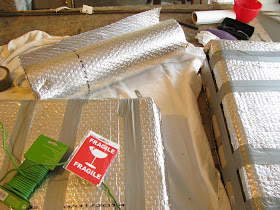Every artist hits a creative slump once in a while.
You want to paint but you don’t know what to paint, or even where to start.
When you do finally put brush to paper, it’s a disaster. The drawing is wrong,
the colours are muddy , the paper misbehaves and the flowers wilt before you
finish.
Instead of painting, you’ll clean the windows or hoover the
house … anything but settle down at that desk. Does this sound familiar?
I often find this happens to me after a break. Even a short
break can interfere with the creative process. Whilst the last few weeks have
been tremendous fun, I’m yearning once more to settle back into a painting
routine, but it’s a struggle.
“Inspiration exists, but it has to find you working”
Pablo
Picasso
So, how can you recover that inspiration and enthusiasm?
1.
Get
organised- Clean that desk and sort
out those paints. Spring-cleaning is a simple, effective ‘pick-me-up’ for the soul.
A clean desk is like a blank canvas inviting you to come and make a mess.
 |
2.
Treat
yourself! Nothing says “Get painting” more than new art materials. Who can
resist the swish of a brand new brush, the lusciousness of a new colour, or the lure of a brand new sketchbook?
 |
| Look what arrived in the post today!! |
I was delighted to
discover that Jackson’s Art are giving away their Daniel Smith ‘palette tester’
dot cards at the moment… yes, free paint! Does it get any better than that? Click here
3.
Play!
Colour charts are a great place to start and so useful too. My lovely friend
Claire sent me a beautiful wooden box with a selection of Daniel Smith earth
colour paints. This is the perfect time to try them out and compare them to my
other earth colours.
 |
| Yummy earth colours! The biggest surprise was to see the difference between Winsor and Newton Raw Umber and the Daniel Smith's Raw Umber |
4.
Inspiration
is everywhere. Find a subject that appeals to you, something that has
caught your eye. I am forever picking up things on walks- seeds, sticks,
shells, leaves, berries- all tiny treasures waiting to be painted.
 |
| I came back from a walk with some oak marble galls and a cedar rose- which I think is the remains of a cone from a Deodar cedar tree. My new colour chart proved very useful! |
5.
Paint
with no expectations- it doesn’t really matter if you finish it or not.
What is more important is that you enjoy the process. If you do end up with
something good, then that’s an added bonus. A good place to start is to grab
some cheap A4 paper and a pencil and just start to draw.
 |
| Lots of scribblings, no expectations, just fun! |
6.
Be
organised. Decide what you want to do the night before, that way you hit
the ground running when you go into the studio.
7.
Set aside
time to paint. You will never find that spare moment to paint, you have to
allocate a certain amount of time each day to satisfy your creative whims. Even
if you allow yourself half an hour a day to do something, you will achieve
something in the end.
 |
| Set yourself the challenge of painting just one leaf a day (or two). Even half an hour of sketching and painting every day can get you back into the routine of painting. |
8.
Keep
motivated! I love my botanical artist friends- they are hugely supportive
and really encouraging. It’s always very inspiring to see their work- just look
at any one of the blogs on the right here. Their enthusiasm keeps me motivated.
 |
| Galls and Roses, Shevaun Doherty 2014. I was very inspired by Sarah Morrish's beautiful painting of galls and was delighted to find my own on a walk. |
9.
Try an
audiobook I discovered audiobooks last year and have since become hooked!
What a fantastic way to spend a day, listening to a great story and painting to
your heart’s content! You really won’t want to leave the studio. I get my all
audiobooks from www.audible.com They have
a huge range to choose from and there’s a month’s free trial for new customers
(yes, more free stuff). The BBC Radio 4
is also great company in the studio- they have some great dramas to listen to.
10.
Plan
ahead. Make a list of all the things that you want or need to do. It could
be preparing work for an exhibition, or starting a commission, or even just
finishing the painting that you started over a year ago for your brother. It’s
a great way to keep you focused and on track.
“You have to keep your bottom to the chair
and stick it out. Otherwise, if you start getting in the habit of walking away,
you’ll never get it done.”
Roald Dahl





























